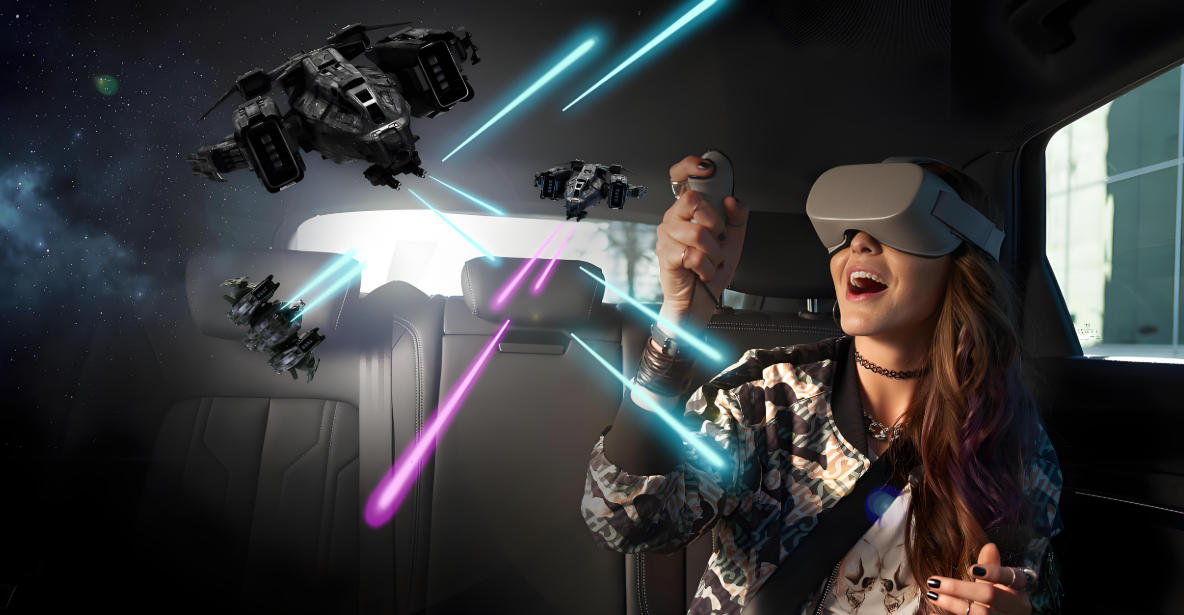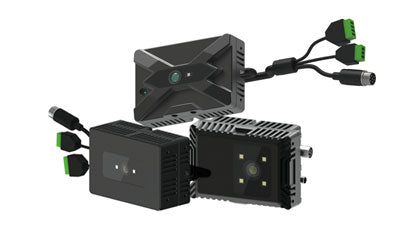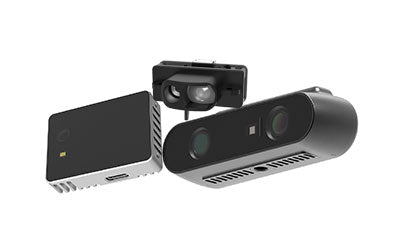TOF Revolution in XR/VR: Technology Behind Truly Immersive Experiences

How Do XR/VR Devices Achieve More Realistic Immersion Through TOF Technology?
In virtual reality (VR), augmented reality (AR), and extended reality (XR) experiences, immersion relies heavily on accurate spatial positioning and natural interaction. However, traditional cameras and inertial measurement units (IMUs) face limitations in positioning accuracy, latency, and multi-user collaboration. TOF (Time-of-Flight) (https://en.wikipedia.org) technology, with its high-precision depth sensing and fast response capabilities, brings a revolutionary change to the XR/VR field, enabling more realistic and immersive virtual experiences.
What Is the Difference Between AR, VR, and XR?
AR, VR, and XR all belong to immersive technologies but differ in focus and experience:
1. Augmented Reality (AR)
-
Definition: Adds virtual information or objects to the real world, allowing users to see both real and virtual elements simultaneously.
-
Experience Features: Users still see the real environment, with enhanced visual, audio, or informational layers.
-
Typical Applications:
-
AR games on smartphones or tablets (e.g., Pokémon GO)
-
Virtual try-on or furniture placement previews
-
Navigation overlays (street guidance, location markers)
-
2. Virtual Reality (VR)
-
Definition: Fully immerses the user in a virtual environment, isolating them from the real world, with experiences entirely generated by computers.
-
Experience Features: Requires head-mounted displays (HMDs) or VR glasses, providing full immersion with visual, auditory, and even tactile feedback.
-
Typical Applications:
-
VR gaming and social interactions
-
Virtual training and simulations
-
Immersive entertainment or virtual tourism
-
3. Extended Reality (XR)
-
Definition: XR is an umbrella term encompassing AR, VR, and Mixed Reality (MR), emphasizing the concept of “extended reality experiences.”
-
Experience Features: XR integrates varying degrees of real and virtual elements to create cross-boundary immersive experiences.
-
Typical Applications:
-
MR applications allowing interaction between virtual objects and the real world
-
Enterprise remote collaboration, remote teaching, or industrial design
-
Multi-platform immersive experiences (AR + VR + MR hybrid applications)
-
Summary Comparison
| Technology | User View | Interaction | Typical Scenarios |
|---|---|---|---|
| AR | Real world + virtual info | Overlay display, gestures, touch | AR games, virtual try-on, navigation |
| VR | Fully virtual environment | Controllers, motion tracking, spatial control | VR gaming, training, virtual tourism |
| XR | AR/VR/MR fusion | Multiple interaction methods | Enterprise collaboration, education, industrial simulation, full sensory experiences |
In short:
-
AR: Real-world dominant, virtual elements secondary
-
VR: Virtual-world dominant, isolated from reality
-
XR: Integrates AR and VR, emphasizing immersive experience and extended interactivity

Pain Points in VR/AR/XR Immersion
Despite rapid development in recent years, users still face several experience challenges:
1. Inaccurate Positioning and Spatial Perception
-
Drift and Offset: Traditional solutions combining visual tracking (SLAM) and IMUs may drift in complex or varying light conditions, causing virtual objects to misalign with reality.
-
Environmental Limitations: Sensors struggle in low light, strong reflections, or narrow spaces, leading to incomplete scene mapping.
-
Immersion Disruption: Floating or unstable virtual objects break the sense of presence.
2. Interaction Latency and Unresponsive Gestures
-
Gesture Recognition Lag: Existing hand-tracking technologies may be delayed or inaccurate, causing lag or misalignment in virtual object manipulation.
-
Delayed Action Feedback: Slow response to hand movements, controller inputs, or haptic feedback hampers precise interactions.
-
Fragmented Experience: Latency impacts gaming, virtual painting, or try-on scenarios, making the virtual and real worlds feel disconnected.
3. Limitations in Multi-User Collaboration
-
Synchronization Challenges: Multi-user VR/XR environments struggle to capture individual movements accurately, causing virtual avatars to move out of sync.
-
Shared Space Restrictions: Latency in updating virtual object positions reduces collaboration efficiency.
-
Immersive Interaction Reduction: Realistic interaction in education, meetings, or multiplayer games is compromised.
4. Scene Adaptability and Environmental Awareness Issues
-
Dynamic Environment Challenges: Systems have difficulty adapting to changing surroundings (light, moving obstacles).
-
Virtual-Real Disconnect: Virtual elements cannot always align accurately with real-world environments, limiting applications in design, try-on, or training.
In summary, these pain points reduce immersion and limit XR/VR applications in education, entertainment, training, and industrial design. Achieving natural, smooth, and collaborative experiences requires breakthroughs in high-precision 3D sensing, low-latency gesture recognition, real-time spatial mapping, and multi-user synchronization.

How TOF Technology Solves Spatial Perception Challenges
Time-of-Flight (TOF) technology emits light pulses and measures the time it takes for the light to return, generating precise depth maps for real-time 3D spatial awareness. In XR/VR/AR devices, TOF effectively addresses traditional spatial positioning and interaction issues, providing the technical foundation for immersive experiences.
1. Real-Time 3D Spatial Positioning
-
High-Precision Depth Sensing: TOF achieves millimeter-level spatial resolution, allowing virtual objects to align perfectly with the real world, eliminating drift or misplacement.
-
Dynamic Environment Adaptation: TOF rapidly updates depth data for moving users or changing scenes.
-
Multi-Scenario Compatibility: Works under indoor/outdoor conditions, low/high light, reflective surfaces, and complex backgrounds.
2. Accurate Gesture Tracking and Natural Interaction
-
Complex Hand Motion Capture: Supports single, dual, or multiple hands, detecting finger bending, stretching, grabbing, rotating, and sliding.
-
Low-Latency Response: Combining TOF depth data with AI algorithms enables millisecond-level gesture recognition, ensuring smooth and natural interactions.
-
Multi-Dimensional Interaction: Gesture tracking powers not only virtual object manipulation but also AR/VR navigation, virtual painting, and game controls.
3. Enhanced Environmental Adaptability
-
Occlusion Handling: TOF senses partial occluded areas, keeping virtual objects stable in complex environments.
-
Multi-User Collaboration Support: Captures positions and actions of multiple users for precise collaborative operations in virtual space.
-
Immersive Experience Enhancement: Accurate spatial awareness integrates virtual elements naturally with reality, boosting realism and interaction in AR/VR/XR scenes.
4. Application Scenarios
-
XR Gaming: Players move freely in real rooms, interacting seamlessly with virtual characters and objects.
-
Virtual Try-On & Home Design: TOF scans rooms and furniture, enabling accurate placement and adjustment of virtual items.
-
Education & Training: Provides precise operational space for immersive simulations, surgeries, or maintenance training.
-
Enterprise Collaboration & Remote Meetings: Synchronizes multiple users’ movements for natural team interactions in virtual environments.
With TOF technology, XR/VR devices can accurately understand the 3D space around users, enable low-latency and smooth gesture interactions, and maintain stability in complex environments. It provides a solid technical foundation for immersive experiences, seamlessly blending the virtual and real worlds to truly enhance user immersion and interactivity.
Achieving Highly Immersive Experiences
Time-of-Flight (TOF) technology not only addresses core challenges in spatial positioning and gesture interaction but also enables seamless integration between the virtual world and real environments, providing a solid technical foundation for XR/AR/VR devices to achieve highly immersive experiences.
1. Multi-User Collaboration and Shared Spaces
-
Synchronized Multi-User Actions: TOF can simultaneously capture the positions and movements of multiple users, enabling real-time synchronization in virtual environments and ensuring natural and smooth collaborative experiences.
-
Enterprise Training and Remote Collaboration: In remote teaching, virtual meetings, or industrial training, TOF precisely captures operational movements and spatial positions, allowing users in different locations to share the same virtual space.
-
Multiplayer Game Interaction: Players can move and interact freely in multiplayer virtual environments, with virtual objects aligning accurately with each player’s actions, enhancing immersion.
2. Full-Space Free Interaction
-
360° Operational Freedom: Users can manipulate virtual objects throughout the entire space without being constrained by fixed controllers or limited camera angles, achieving natural interaction from any viewpoint.
-
Support for Complex Gestures and Movements: TOF captures hand, finger, and body movements, supporting multi-dimensional actions such as grabbing, rotating, throwing, and stretching.
-
Enhanced Immersive Experience: Virtual objects integrate seamlessly with real-world surroundings, allowing users to interact as naturally as with physical objects and experience intuitive spatial presence.
3. Dynamic Environment Adaptation and Intelligent Response
-
Real-Time Depth Updates: TOF continuously scans the environment, dynamically generating up-to-date 3D depth maps so virtual content intelligently adapts to changes in the real world.
-
Automatic Adaptation to Environmental Changes: Whether lighting shifts, furniture moves, or new objects appear, virtual elements automatically reposition and maintain interactive functionality.
-
Natural Interaction Experience: The system intelligently triggers responses based on environmental data and user actions, enabling realistic interaction between virtual objects and the real world.
4. Extended Application Scenarios
-
Education and Training: Immersive virtual labs, surgical simulations, or mechanical operation training make learning and practice more intuitive and safe.
-
Healthcare and Rehabilitation: In rehabilitation or remote surgery guidance, TOF provides precise spatial awareness and gesture tracking, improving operational safety and effectiveness.
-
Industry and Design: Virtual prototyping, factory process simulation, and equipment operation training benefit from TOF’s high-precision and multi-user collaboration capabilities.
-
Entertainment and Gaming: Panoramic AR/VR games, virtual performances, and interactive experiences provide highly immersive and freely manipulable spaces.
With TOF’s real-time 3D perception, gesture tracking, and environment adaptability, XR/AR/VR devices can achieve multi-user collaboration, full-space free interaction, and dynamic environment responsiveness, significantly enhancing immersion and interactivity. Such highly immersive experiences not only improve entertainment enjoyment but also provide more intuitive, safe, and efficient interaction methods for professional applications in education, healthcare, and industrial training, laying a solid foundation for the future of virtual reality.

Industry Applications and Success Stories
As TOF (Time-of-Flight) technology matures in XR/VR devices, its applications in industry, education, entertainment, and corporate training are expanding, demonstrating significant value and tangible results.
1. VR Entertainment and Virtual Social Interaction
-
Oculus (Meta Quest Series): Integrated TOF sensors enable precise hand tracking and indoor spatial awareness.
-
Multiplayer VR Games: Player movements are captured in real time and mapped onto virtual avatars, improving interaction naturalness and immersion.
-
Virtual Social Spaces: TOF supports multi-user shared virtual spaces, ensuring accurate synchronization of gestures, movements, and spatial interactions.
-
Effect: Users experience smoother operation, intuitive control, and minimal alignment errors between virtual scenes and real-world environments.
-
-
Pico: Combines depth sensing and TOF to enable remote collaboration, virtual meetings, and immersive training scenarios.
-
Remote Collaboration: Users share actions and operations in real time within the same virtual space, enabling cross-location teamwork.
-
Immersive Meetings: Virtual offices, 3D whiteboards, and interactive tools make online meetings feel more realistic.
-
Training and Education: Supports skill training, simulated operations, and practice exercises, reducing physical equipment usage and risk.
-
2. Enterprise Training and Professional Education
-
Industrial Training: TOF+XR simulates mechanical operations, assembly workflows, and hazardous environments, allowing safe skill practice in virtual scenarios.
-
Medical Education: TOF captures surgical movements and operational details, enabling surgical simulations, remote guidance, and skill assessment, reducing medical risks.
-
Education & Training: Immersive laboratories and virtual classrooms allow students to study scientific experiments, engineering design, or complex operations in interactive 3D environments, improving learning efficiency and safety.
3. Success Stories and Outcomes
-
Oculus Multiplayer VR Games: Motion recognition accuracy improved by 30%, multi-user interaction latency reduced by 50%, significantly enhancing gaming immersion.
-
Pico Virtual Meetings: TOF sensors combined with XR platforms increased remote collaboration efficiency by 40%, with noticeably higher user engagement.
-
Enterprise Training: Using TOF+XR simulations reduced operational errors by 20%, shortened training time by ~30%, and lowered practical risks.
4. Industrial Value
TOF technology in XR/VR not only optimizes user experiences but also creates business value:
-
Efficiency Gains: Reduces physical operations and training costs while improving remote collaboration and teaching efficiency.
-
Enhanced Immersion: Accurate spatial perception and gesture interaction make virtual worlds closer to reality.
-
Safety Assurance: Virtual operations replace real-world tasks in hazardous environments, minimizing potential injuries.
-
Market Expansion: Provides differentiation and competitive advantages for VR entertainment, enterprise training, and medical education industries.
These applications and success stories show that TOF technology not only improves user experiences in XR/VR devices but also provides efficient, safe, and immersive solutions for enterprises, education, and professional training. Its 3D spatial sensing capability is becoming a core technological support for XR/VR industry upgrades and innovation.

Future Trends
With the rapid development of Artificial Intelligence (AI), 5G communication, and cloud computing, TOF (Time-of-Flight) technology will continue to play a pivotal role in the XR/VR ecosystem, providing core support for immersive experiences.
1. AI + TOF Intelligent Interaction
-
Gesture Prediction and Motion Recognition: Using deep learning algorithms, TOF sensors capture hand and body movements to predict the next action, enhancing interaction fluidity.
-
Dynamic Scene Adjustment: AI analyzes environmental changes, allowing virtual objects to adapt in real time and seamlessly merge with reality.
-
Personalized Interaction: AI learns user behavior and preferences, optimizing interfaces and feedback for a smarter XR/VR experience.
Example: In VR games, the system anticipates user hand or body movements and renders responses instantly, reducing latency and operational errors.
2. Ultra-Low Latency and High Frame Rate Experiences
-
5G Connectivity: High-speed, low-latency 5G enables cloud XR and multi-user collaboration for real-time remote interaction.
-
Edge Computing Integration: Processing data at edge nodes reduces transmission paths, achieving millisecond-level responses.
-
Real-Time Rendering Optimization: TOF provides precise depth data for synchronized updates of virtual objects with the real environment, ensuring stable visuals and accurate operations.
Application: Remote VR training, virtual meetings, and multiplayer games experience near-zero latency, enhancing immersion and natural interactions.
3. Holographic Display and Cloud XR
-
Holographic Display Support: High-precision 3D spatial data from TOF enables holographic projection, accurately mapping virtual objects in real space.
-
Cloud Rendering and Collaboration: Complex scenes and high-precision graphics can be rendered remotely, while TOF ensures spatial interaction accuracy.
-
Remote Multi-User Immersion: Multiple users share the same virtual space with synchronized actions, environmental feedback, and consistent interaction experience.
Example: In remote enterprise collaboration, employees in different locations can design or simulate operations on a cloud XR platform, with virtual object positions precisely aligned with real actions.
4. Cross-Scenario Expansion
TOF+XR applications will extend beyond entertainment and gaming to healthcare, industry, education, and remote work:
-
Medical Training and Surgery Simulation: Precise gesture tracking and spatial modeling support surgical practice and remote guidance.
-
Industrial Operations and Safety Training: Complex machinery operations can be safely simulated in virtual environments.
-
Remote Work and Virtual Meetings: Multiple users share virtual office spaces, with synchronized gestures and actions improving collaboration efficiency.
-
Education and Research: Immersive experiments and scientific simulations enhance learning experiences and enable interactive remote education.
5. Full-Sensory Immersion Trend
In the future, TOF will not only enhance visual immersion but also promote full-sensory experiences:
-
Haptic Feedback Integration: Combined with haptic gloves or force-feedback devices, enabling tactile perception of virtual objects.
-
Spatial Audio Integration: TOF-based spatial modeling provides precise location data for 3D audio synchronization with virtual environments.
-
Environment-Adaptive Interaction: Virtual objects dynamically adjust based on user position, movements, and environmental changes for intelligent immersion.
Conclusion
In the future, TOF technology will become a core pillar of the XR/VR ecosystem, driving virtual experiences from single-sensory visual immersion to full-sensory, low-latency, intelligent, and multi-scenario immersive experiences. Across entertainment, education, healthcare, and industrial applications, TOF+XR will offer users a more realistic, interactive, and intelligent virtual world experience.
Synexens 3D Of RGBD ToF Depth Sensor_CS30
Our professional technical team specializing in 3D camera ranging is ready to assist you at any time. Whether you encounter any issues with your TOF camera after purchase or need clarification on TOF technology, feel free to contact us anytime. We are committed to providing high-quality technical after-sales service and user experience, ensuring your peace of mind in both shopping and using our products.



